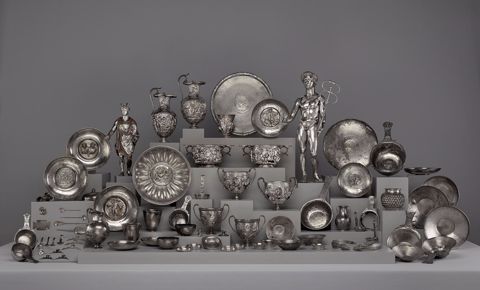“Ancient Luxury and the Roman Silver Treasure from Berthouville” completes U.S. Tour at the Museum of Fine Arts, Houston

Roman, The Berthouville Treasure, silver and gold, Bibliothèque nationale de France, Département des Monnaies, médailles et antiques, Paris.
Roman, The Berthouville Treasure, silver and gold, Bibliothèque nationale de France, Département des Monnaies, médailles et antiques, Paris.
Roman, Cameo of Emperor Trajan, c. 100 AD, sardonyx set in a 17th-century gold, enamel, and ruby mount, Bibliothèque nationale de France, Département des Monnaies, médailles et antiques, Paris.
Roman, Cameo of Emperor Trajan, c. 100 AD, sardonyx set in a 17th-century gold, enamel, and ruby mount, Bibliothèque nationale de France, Département des Monnaies, médailles et antiques, Paris.
Roman, Plate with the Embassy to Achilles (The Shield of Scipio), 375–400 AD, silver and gold, Bibliothèque nationale de France, Département des Monnaies, médailles et antiques, Paris.
Roman, Plate with the Embassy to Achilles (The Shield of Scipio), 375–400 AD, silver and gold, Bibliothèque nationale de France, Département des Monnaies, médailles et antiques, Paris.
More than 170 objects, regarded among the finest surviving works of ancient Roman silver
Houston, Texas—October 13, 2016—Next month, the Museum of Fine Arts, Houston, presents Ancient Luxury and the Roman Silver Treasure from Berthouville, an exhibition of over 170 objects from the ancient Roman Empire, including an opulent collection of silver objects known as the Berthouville Treasure. This cache—accidentally discovered by a French farmer in the early 19th century and recently conserved by the J. Paul Getty Museum—will be displayed alongside a selection of precious gemstones, glass, jewelry, and other Roman luxury items from the royal collections of the Cabinet des Médailles of the Bibliothèque nationale de France. The exhibition will be on view in Houston from November 6, 2016, to February 5, 2017.
“The Museum of Fine Arts, Houston, is honored to be the final U.S. stop for these significant treasures before they return to France next spring,” said Gary Tinterow, director of the Museum of Fine Arts, Houston. “We’re particularly grateful to the Getty Museum for their expertise and dedication in conserving the Berthouville Treasure, paving the way for additional research and study of these important antiquities.”
“These unique objects offer insight into the diverse role luxury arts played in ancient society at the time,” added Frances Marzio, MFAH curator, antiquities, and organizing curator of the Houston presentation. “In examining the techniques employed by ancient craftsmen in designing and creating these treasures, fascinating aspects of Roman technology, culture, and religion are revealed.”
Highlights of the exhibition include the “Patera of Rennes,” a shallow libation bowl that remains one of the few surviving examples of Roman gold tableware; the “Shield of Scipio,” a silver and gold plate depicting the Homeric hero Achilles, extracted from the Rhone river in 1656; and a bejeweled cameo of the Emperor Trajan, intricately carved from multilayered sardonyx.
The Berthouville Treasure
In March of 1830, while plowing a field near the village of Berthouville in Normandy, France, a farmer named Prosper Taurin struck an ancient tile, revealing a buried cist. Within the cist, he discovered a cache of approximately 90 Roman silver objects weighing 55 pounds and dating back to the first and second centuries A.D. Now known as the Berthouville Treasure, the hidden stash included two statues of the god Mercury and more than 70 elaborately decorated vessels, many of which depicted mythological scenes. This spectacular hoard of objects is presented in its entirety for the first time outside of Paris in Ancient Luxury and the Roman Silver from Berthouville.
Soon after Taurin’s rich discovery, the Berthouville Treasure was acquired by the collections of the Cabinet des Médailles of the Bibliothèque Nationale of France, where it has resided since the 19th century. In December 2010, the entire collection was sent to the J. Paul Getty Museum’s Antiquities Conservation Department in Los Angeles for a comprehensive conservation treatment. Ancient Luxury and the Roman Silver Treasure from Berthouville is the celebration of a four-year project to research, conserve, and meticulously clean the collection. A video detailing ancient silversmithing techniques used by Roman craftsmen—the result of years of in-depth research undertaken by the Getty—will supplement the objects on display. Houston is the last stop on the four-venue U.S. tour of the exhibition.
Catalogue
The exhibition is accompanied by a fully illustrated catalogue, The Berthouville Silver Treasure and Roman Luxury, published by Getty Publications.
Organization and Funding
This exhibition was organized by the J. Paul Getty Museum in collaboration with the Bibliothèque nationale de France, Département des Monnaies, médailles et antiques, Paris.
 |
 |
In Houston, this exhibition is dedicated to the memory of Isabel Brown Wilson with generous support provided by:
Kinder Foundation
The Brown Foundation, Inc.
Nina and Michael Zilkha
Wallace S. Wilson
About the MFAH
Established in 1900, the Museum of Fine Arts, Houston, is among the 10 largest art museums in the United States, with an encyclopedic collection of more than 65,000 works dating from antiquity to the present. The main campus comprises the Audrey Jones Beck Building, designed by Rafael Moneo and opened in 2000; the Caroline Wiess Law Building, originally designed by William Ward Watkin, with extensions by Ludwig Mies van der Rohe completed in 1958 and 1974; and the Lillie and Hugh Roy Cullen Sculpture Garden, designed by Isamu Noguchi and opened in 1986. Additional spaces include a repertory cinema, two libraries, public archives, and facilities for conservation and storage. Nearby, two house museums—Bayou Bend Collection and Gardens, and Rienzi—present American and European decorative arts. The MFAH is also home to the Glassell School of Art and its acclaimed Core Residency Program and Junior and Studio Schools; and the International Center for the Arts of the Americas (ICAA), a leading research institute for 20th-century Latin American and Latino art.
1001 Bissonnet, Houston, Texas 77005 | www.mfah.org | 713.639.7300
Media Contact
Laine Lieberman, publicist
713.639.7516 / llieberman@mfah.org
